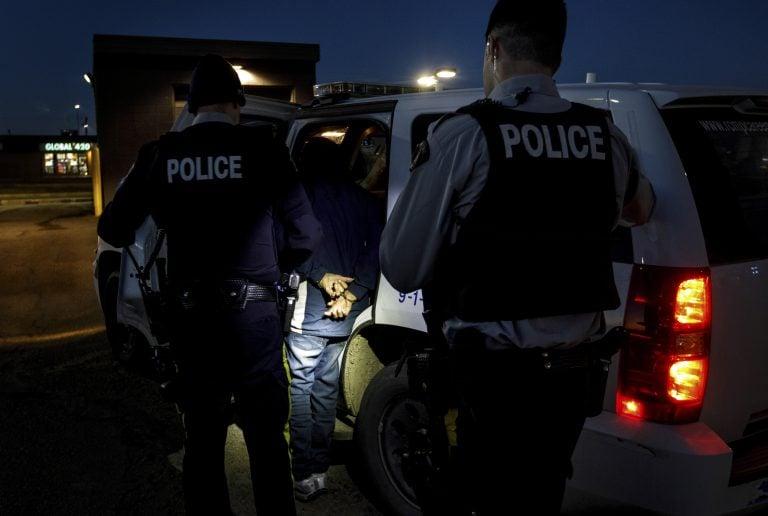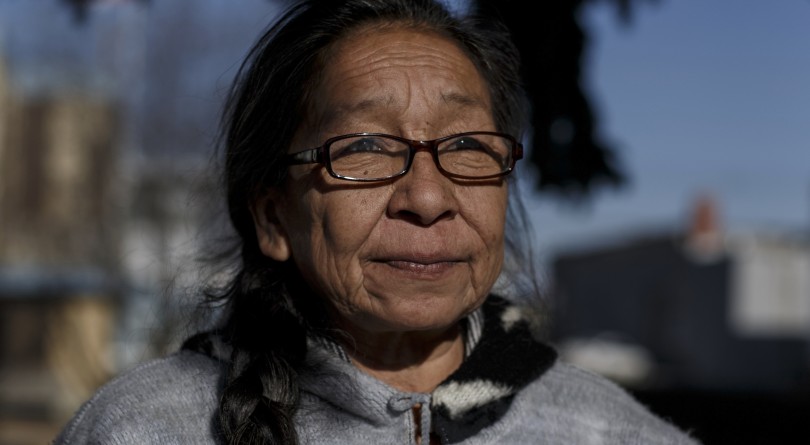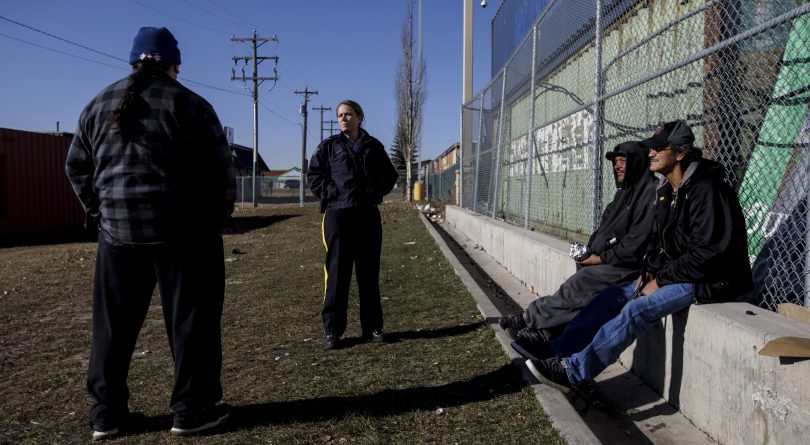Canada’s fastest-growing crime problem is in Wetaskiwin, Alta.
Crime’s getting worse in Wetaskiwin, in an awful hurry. Can the city get a handle on it?

RCMP officers arrest a woman for public drunkenness in Wetaskiwin, Alta., on Oct. 23, 2018. (Photo by Jason Franson)
Share
A newcomer might receive several different tours of Wetaskiwin when reporting on crime in the central Alberta city. Susan Kokas, a local resident, starts her excursion by driving past one of the commercial buildings where she once worked as a cleaner. Pointing to trees at the end of the cul-de-sac, she says a young First Nations woman was found dead there a couple of years ago.
A self-described “poor” resident who’s lived close to the town’s troubles, Kokas ticks off a list of petty, seemingly pointless crimes she’s endured, like the theft of paint cans she’d kept in her backyard while doing artwork; local gangs made a habit of walking through the alleyway behind the modest home where Kokas rented a basement suite, grabbing whatever they saw. But what rattled her most was the fatal stabbing of a young man in a parking lot mere blocks from her home—a killing that prompted her to hold a “violence vigil” in a nearby park last fall. About 20 people showed up.
Kevin Lonsdale, the city’s deputy mayor, begins his sightseeing on the opposite side of town, driving past the local hockey arena and a football field where happy-go-lucky kids are running around as parents dutifully wait for practice to end. His tour showcases a city that’s only an hour’s drive south of Edmonton, with a population of about 12,600, yet still retains its small-town vibe and Prairie roots. It’s a place where Lonsdale spends his spare time coaching minor football and where every patron at a local restaurant appears to know his name. He talks about how perfectly safe he feels in this community. His daughter and her family live about a block from a reputedly dangerous dead-end street, he says, but neither he nor they worry about their safety. “If you want to look for trouble, you’ll find it,” Lonsdale says. “But every city has crime—unless you’ve got Superman.”
READ MORE: Canada’s most dangerous places 2019: Rank your city
Suffice to say, when both tour guides are told that Statistics Canada data shows Wetaskiwin had the fastest-growing Crime Severity Index score in the country between 2012 and 2017, the dichotomy between their responses exposes how polarized attitudes in the community have become toward crime. In Lonsdale’s eyes, Wetaskiwin remains a livable place with all the amenities and attractions befitting a city of its size. “This town’s been good to me and my family,” he says. To Kokas and others, such reassurances ignore what data and lived experience have been telling them for years: there’s a crime problem here, it’s getting worse, and it’s increasingly hard to pretend otherwise.
The first thing an outsider notices is the abundance of car dealerships on what’s known in Wetaskiwin as the “Auto Mile.” It’s the reason people from across the province make trips here when they’re in the market for a new ride. As the famous advertising jingle goes: “Cars cost less in Wetaskiwin.”
Local RCMP, though, are more invested in getting a handle on stolen cars. Property crime is a growing concern, especially motor vehicle theft. When Wetaskiwin RCMP Insp. Keith Durance instructed a colleague to read every file on motor vehicle thefts in 2017, they found that 38.5 per cent of cases in the city involved keys being easily accessible to the criminal: vehicles left running; an unlocked car with keys hidden under a sun visor; keys left on a nail hanging in an unlocked garage. (In the surrounding rural area, it was 42 per cent.)
Many residents still have that small-town Canadian mentality—they don’t lock their cars or doors, says Durance. “It’s not right that someone is going to come to your house and steal your car,” he says. “But if you locked the door and kept the keys in your pocket, they wouldn’t be stealing it.”
So the RCMP detachment is starting a “lock your car” campaign. But addressing property crime also requires boots on the ground, and for Durance, that meant bolstering his crime-reduction unit by three officers. “When I first got here [18 months ago], it was a one-person team—which doesn’t make a team,” he says. A major part of the unit’s strategy is to focus on prolific offenders, Durance says, including those who might be on bail or released on probation. A dedicated team can not only compile analytics but also keep up with mundane but meaningful things like curfew checks on parolees or suspects out on bail. With about eight per cent of the criminals accounting for 80 per cent of the property crime in town, Durance reasons that concentrating on those frequent offenders will produce a steep decline in property crime.
It’s a good start, but the main driver behind the increase in the city’s crime-severity score is serious violent crime, such as assault with a weapon and assault causing bodily harm, which more than doubled between 2012 to 2017, from 43 offences to 94. Aggravated assault rose from one offence to 10. There were also two homicides last year, whereas the city saw just one (in 2014) over the previous five-year period.
Writer Aaron Hutchins discusses how Wetaskiwin can handle Canada’s fastest-growing crime problem, on The Big Story Podcast.
Altogether, Wetaskiwin’s Crime Severity Index numbers peg it as the most dangerous city in Alberta—and the third most dangerous in the country. (Maclean’s uses Statistics Canada’s annual crime data to produce a report ranking Canada’s 237 population centres with 10,000 or more people. StatsCan’s Crime Severity Index is a measure of both the number and seriousness of crimes in a given area. The most dangerous place in Canada, according to the index, remains North Battleford, Sask.—a city that Maclean’s profiled last year. It shares some demographic features with Wetaskiwin, including population size and status as a hub to surrounding rural communities.)
But Tyler Gandam, the mayor of Wetaskiwin, stresses that the city’s growing crime-severity numbers should not be interpreted to mean law-abiding residents are in danger. “If there’s a rise in the number of assaults, it’s between people who know each other,” he says. “They’re not random acts of aggression or people getting robbed. I think that’s where residents might feel more scared seeing us ranked No. 1 in the province. But they’re not in any danger of getting assaulted. It’s two people who have a beef with each other already.”
RELATED: Canada’s safest places
No local politician who spoke with Maclean’s would say Wetaskiwin has a crime problem. If anything, they argue, the area has a Crime Severity Index problem. The number is not, says city councillor Patricia MacQuarrie, a measure of community safety: “It wasn’t that overall crime in the city grew from eighth worst [in the country] to third worst. It’s a case of very few, but very major, instances increasing our severity to that level because of our [smaller] population.”
The small-population argument is echoed at the city’s RCMP detachment. “It doesn’t take long for the crime severity to ramp up, particularly if you’re having a certain type of crime rearing its head,” says Durance. “We had 28 robberies in January and February this year, which is unheard of. So I suspect with next year’s crime severity, we’ll be up there again because of the armed robberies in January and February.” Durance is quick to point out that his team solved 26 of those robberies.
Of course, the logic of that math also means a smaller city can, through luck or good management, turn around its ranking. In 2012, Estevan, Sask., ranked as the 20th most dangerous place in the country. When police chief Paul Ladouceur came to the city of 11,000 two years later, the biggest problem was drugs and related enterprises. “We had massage parlours, [biker] clubhouses and organized crime,” he says. “No community likes to say, ‘We have a drug problem.’ ”
Ladouceur could see that cocaine and crack use were the root cause of much of the city’s spinoff crime—break and enters, robberies, home invasions, offences involving weapons. His answer was to apply a principle of business to policing: “We’re in the business of public safety, and a good business follows up with its customers,” he says.
It’s something police forces don’t all do well. Many residents who call to report a suspected break-in down the street never hear from the cops again. In Estevan, says Ladouceur, “we make a very strong point of reaching back out and saying: ‘Hi, you called with information on a possible impaired driver last night. We just wanted to thank you because we caught that person, they blew well over the legal limit, and you likely saved somebody’s life. Congratulations.’ ” It goes a long way. Not only do residents appreciate police following through with the information, he says, it makes them more likely to report other crimes in the future.
Ladouceur credits that trust-building for helping make Estevan the city with the fastest-shrinking crime-severity number in Canada. It’s 91st in this year’s Maclean’s rankings. The biggest step, according to the chief, was facing up to the truth. “We told the town, ‘We have a drug problem—and we need your help.’ It is amazing when you ask questions bluntly. The calls start coming. A good portion of that is trust—trust that the police will do something.”

Wetaskiwin, to be sure, is not a scene from Mad Max. Friendly locals are out shopping, eating in restaurants and walking down Main Street. But ask a handful of random strangers about crime, and you’ll get a story.
Jennifer Threefingers says she was assaulted in her Wetaskiwin home two months ago. The patio door was open and “this guy—we know him but he’s not a good friend—walked in,” she says. “He pulled my hair and kicked me in the face. It was ugly.” She says she reported the incident and the man was arrested.
Larry Jensen, a 54-year-old who stopped to chat outside his low-income apartment on his way home from work, wishes he could move to a quieter, cleaner and safer neighbourhood in Wetaskiwin’s north end. But he can’t afford it on his wages as a mechanic’s assistant. “This is a seedy town,” says Jensen, who’s lived in Wetaskiwin since the early 1990s. “I don’t like to say that, but that’s what it is. When the sun goes down, the crazies come out.” The windows on his old Dodge were smashed on one occasion. Another time, the tires were slashed.
Jensen laments the proliferation of liquor stores and pawn shops in the city. While taking out his trash at night, he says, he has heard the sound of people trying to open car doors—and the quiet exclamation, “This one’s open!” Though he stands about six foot five, he says he’s quick to turn back indoors: “I’m not going to go be some crime-fighter.”
Teresa Callihoo, whose children are Indigenous, says there’s a perception that First Nations people from the neighbouring city of Maskwacis are the perpetrators of most of the crime in Wetaskiwin. It’s true, she says, that gang violence began “ramping up” in Maskwacis a decade ago, when she was working for the city of Wetaskiwin on a crime prevention program. Several years ago, one of the reserves passed a bylaw to evict known gang members living there.
But she notes that Maskwacis, which serves four reserves, was also home to the Ermineskin Indian Residential School that shut down in 1973. “The intergenerational trauma—that’s what we’re seeing playing out in [Wetaskiwin] with the crime, homelessness and addiction,” says Callihoo, who lives in Wetaskiwin with her kids. “I think what is perceived as inaction in [Wetaskiwin] is maybe just cautious planning—how to handle the optics of a rising crime rate without alarming people, and how to maintain the relationship between our community and Maskwacis.”
A growing homelessness problem doesn’t help, and is made all the more complicated as the city doesn’t have a shelter. The city is working on building a Friendship Centre to help with shelter, food security and social services for those in need, but it’s far from breaking ground. In the meantime, residents complain about the homeless—most of them First Nations people who are found sleeping inside the entryways to apartment buildings or bank branches in a place where winter temperatures plunge below -20° C. Photos of their makeshift sleeping quarters often wind up on a “Wetaskiwin Rant and Rave” Facebook page.
READ MORE: How we ranked Canada’s dangerous cities
This fall, the city put up wooden shed-like structures in an empty field next to the Walmart to help protect the homeless from heat and rain. They’d previously been used as dugouts at the local baseball diamond, but such structures are also used in the area as shelters for cattle. Proponents argued it was at least something, anything, to help, and locals would venture out to the field to offer blankets or water. “Those sheds were a positive effort,” says Sherry Greene, who’s originally from Maskwacis. “My brother is homeless. We worried about him every night. We knew those sheds were helping him.”
But critics argued the makeshift solution wasn’t enough—never mind the optics of using livestock sheds for people. In any event, mere weeks after they were installed, they burned down. A fire spread from a burn-barrel brought close to the structures for warmth.
In town, some of the homeless are known as the “Regulators.” (The origins of the name aren’t clear, but according to Old West lore, Billy the Kid’s gang used it.) For the most part, they are harmless, but the RCMP’s Durance says “these Regulator folks” take up a disproportionate amount of police resources: “They’re spending the night in the drunk tank because they’re out causing problems and we have to scoop them up. This is a social problem, not a policing problem.”
On a recent weekday morning, a group of unemployed First Nations men sit in an empty patch of land behind a liquor store. “We’re just bored,” says Cary McGilvery, who is originally from St. Paul, Alta., but has lived in Maskwacis for 26 years. “Like me today, I came over because I had nothing to do at home.” McGilvery seems resigned to his situation. “It’s a lack of jobs, lack of employment and lack of communication with the reserve.”
As he speaks, a man shows up and strikes up a conversation with one of the other men sitting around.
“Did you get charged?”
“For what?” the other replies.
“That knife.”
“Oh. No.”
The newcomer then recognizes someone with a notepad, introduces himself, learns he’s speaking with a journalist and walks away. No word on what happened to the knife.
“Our Regulators will often pass out and get robbed. Some are elderly and not in great physical condition, so they started carrying knives on them,” says RCMP Cpl. Laura McGilvray. “But if they’re carrying a weapon and pull it out, now we’re responding to a weapons offence.”

Wetaskiwin has added three RCMP positions over the past two years. Durance says he’s put in a request for three more for next year. “When I ask the city for more resources, it’s a big ask,” he says. “Policing is expensive, and Wetaskiwin is not a bustling metropolis.” The mayor says he’s budgeted for two new RCMP members. But MacQuarrie would also like to address crime prevention through environmental design. “I want to see more lights,” the third-term councillor says. “I want to see us restructuring our infrastructure to ensure we have spaces in the community with good sightlines, that people are accessing and feel safe.”
What might that look like? Kokas drives past Jubilee Park, where she sees her former neighbour out walking the dog. The pup and its master are relatively easy to spot as lights shine down on a chilly October evening. And this is worth pointing out, Kokas says, because Jubilee “used to be crackhead park. Nobody would go there. I never went there. It was scary.”
On this, she speaks with authority: at the time, she lived two houses away from it. Now, she says, things have changed. The city added lighting, benches and garbage cans, and trimmed down the high hedges so anyone driving down Main Street can see into the park. Kokas credits the changes as one of the more successful initiatives to address the growing concern over crime—a flicker of encouragement.
But she won’t be wandering the park with regularity any time soon. The “violence vigil” she held last year drew the local MLA, but no city politician. A Facebook page she launched, called “Citizens for a Safe Wetaskiwin,” didn’t gather much steam, so she shut it down. Worse, she says, being vocal about local crime made her a frequent target on the “Rant and Rave” Facebook page. So she finally gave up and moved a few kilometres out of town. “You get exhausted,” she says. “I was tired of all the ugly.”